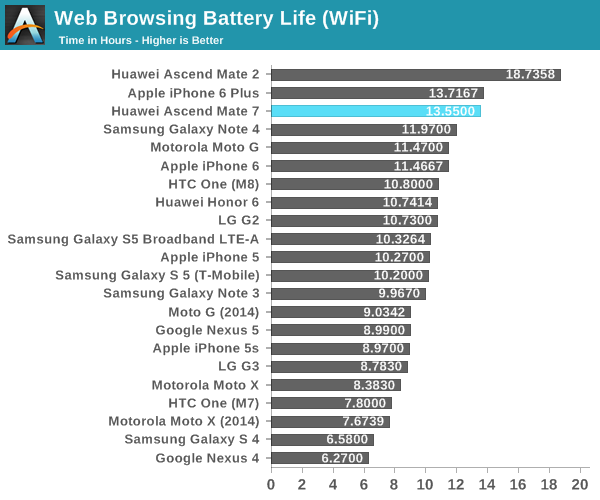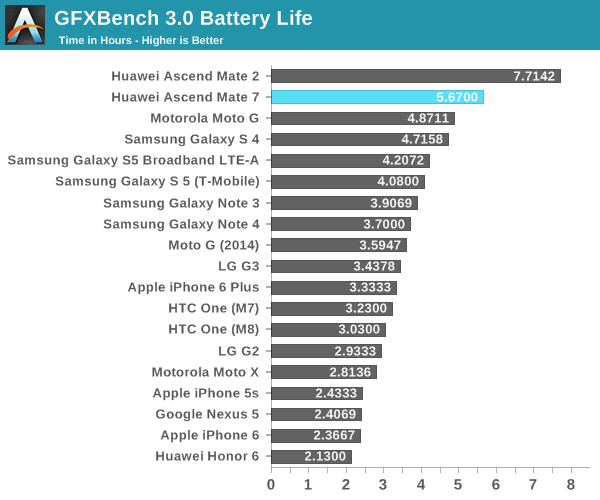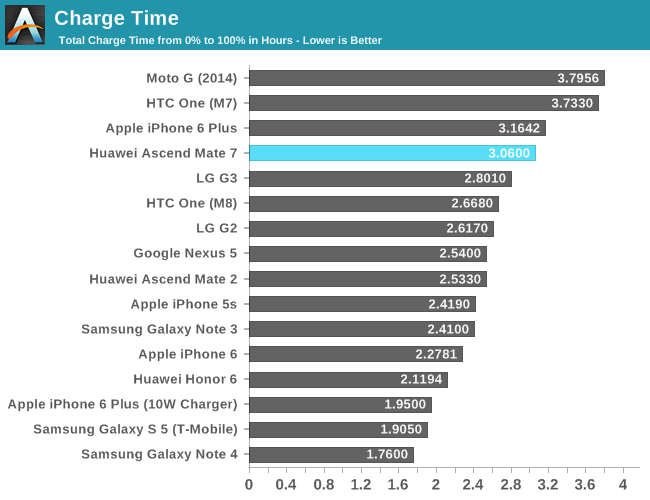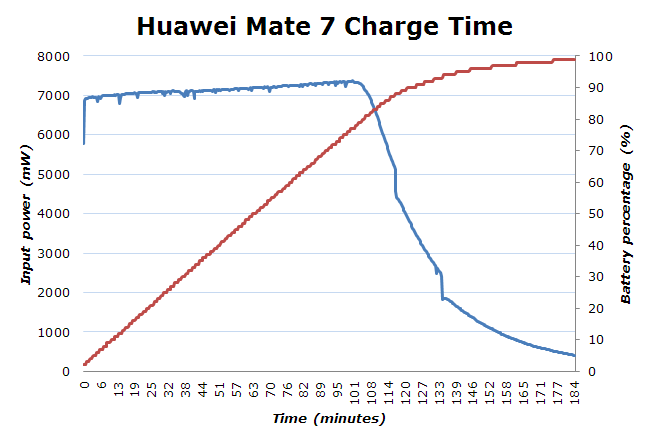The Huawei Ascend Mate 7 Review
by Andrei Frumusanu on December 2, 2014 8:00 AM EST- Posted in
- Smartphones
- Huawei
- Mobile
- Ascend Mate 7
- HiSilicon
Battery Life
We find a monstrous 4100mAH battery inside of the Mate 7 which should theoretically provide it excellent runtimes. Let's see if that is the case.

The Wifi web-browsing test ends up at 13.5 hours for the Mate 7. While this is a enormous lifetime for usual Android devices, it's pretty disappointing in conjunction with the size of the battery. The iPhone 6 performs almost equally with a 1200mAh smaller battery. Even the Note 4 with its AMOLED screen which is usual unfavourable to our web-browsing test isn't too far behind with its 3200mAH battery. Of course the Mate 7 has a slightly bigger screen, but it's still only 1080p compared to the Note 4's. I would have expected the Mate 7 to be in the range of its predecessor, the Mate 2, but that device remains very lonely among the top of our battery charts.
I did not do a objective run on 4G to be able to test the new Balong modem inside the Kirin. This is mostly due to a very different test environment than what we've ran our previous devices, mostly by Josh and Brian under 700MHz on AT&T. Here in Luxembourg we still only have access to 1600MHz LTE while 800MHz EUDD is still being freed for commercial use. As such, I prefer to avoid publishing any misleading numbers until I get a good portfolio of devices which I can all run under the same test conditions.
I can however give my subjective opinion on the matter: I haven't been impressed at all by Huawei's new modem. In daily usage under a mobile connection the device gets quite hot and drains the battery more than other devices sporting Qualcomm modems. I'm very skeptical of Huawei's modem and RF back-end, and hope that in the future they'll be able to improve power consumption.

You might be wondering where the Mate 7 is on the BaseMark OS II graph. The truth is rather ugly.
I've tried several times to complete the battery test on BaseMark OS II and failed each time. After 25 minutes the device would shut off due to overheating and reach scorching hot temperatures. This is the hottest I have ever seen any mobile device be, and I could not comfortably hold the device after it crashed on the test. The phone discharged at a rate of 0.7% per minute during those 20 minutes, meaning it should have reached about 2.3 hours of lifetime, again one of the worst scores we've ever seen, short of the Honor 6. This projects a sustained TDP of about 6.5W, much above what a phone factor is able to dissipate.

The GFXBench 3.0 battery run is much improved over the Honor 6, again due to more aggressive thermal throttling on the GPU. Here the Mate 7 manages to reach 5.6 hours lifetime, but with a great performance sacrifice.
Overall, I deem the Mate 7 battery life to be bad, and a step back in terms of efficiency. For users who just browse a lot with their device or frequently use social media applications, the Mate 7 performs quite well. If you are a frequent gamer, I'd strictly recommend against the Mate 7.
Charge Time
The Mate 7 uses a what has now become a standard 5V 2A charger. The charger IC sets up a 1750mA input power rate which ends up at around 7W charge power in the fast-charge phase of the battery before it slows down to three slower phases of trickle-charging.

We see a similar charge curve as on the Honor 6; the power decreases a lot after reaching 85% at the 100 minute mark and it takes another 85 minutes to fill the last 15% for a total of a little over 3 hours. This is neither bad considering the 4100mAh battery, but nothing to write home about either, especially since we've seen in the introduction of chargers at increased voltage operation.











72 Comments
View All Comments
Laststop311 - Tuesday, December 2, 2014 - link
Wish we could have some american phones with battery life like this.arsjum - Tuesday, December 2, 2014 - link
Andrei,Any chance you'll be reviewing Galaxy Note 4 exynos version?
Andrei Frumusanu - Tuesday, December 2, 2014 - link
I've been working on the article for 2 weeks, it's coming.DanD85 - Tuesday, December 2, 2014 - link
Thanks for reviewing this Huawei phone, anandtech. These days, Chinese manufacturers have much more interesting devices compare to the old players. Anandtech has been my favorite tech review site for more than 10 years and you guy offer the most in depth review on the whole interweb. Keep up the great work!Sicariase - Wednesday, December 3, 2014 - link
Seriously Andrei, thanks for this review. I've been tossing up between the note 4 and this for a couple of weeks, and just decided to get the huawei (didn't think the differences were massive from other reviews) when this review came out. You've potentially saved me from a world of disappointment.Bondurant - Wednesday, December 3, 2014 - link
As with other reviews on this site, the problem in this review is that there is no corresponding reference to real life usage. Just lots of numbers but for example why not a real life gaming comparison between Mate 7 and Note 4 ? NAND performs horrible in benchmarks but if in real life there is barely any noticeable change, than does the benchmark score even matter ? How about comparing the photos with other 13MP IMX214 phones ? Also frustrating i found is there is no explanation as to what exactly is the cause of poor battery performance of Mate 7, is it the fault of GPU or their modem or that it does not use a amoled screen like Note 4 ? Is it a fixable issue with rom updates ?Ofcourse ideally Huawei could have simply thrown in some Qualcomm and so on like Samsung does, but it prevents the development of Hauwei's own innovations and implementations. HiSilicon from its last year K3V2 to this years Kirin 925, there is huge improvement and they are already releasing their 64bit chip kirin 930 this December and a Kirin 950 in June.
Andrei Frumusanu - Wednesday, December 3, 2014 - link
Basically the cause of bad battery life is that power consumption of the Kirin SoC is too high - I've explained this in the review of the Honor 6 where I took an in-depth look into the chip.Bondurant - Wednesday, December 3, 2014 - link
But a comparison between Honor 6 and Samsung S5 (both the Qualcomm and Exynos version) battery life don't show Kirin SOC having such suspected high battery drain problem, although yes you did mention ways battery life could have been improved but nothing to say of a huge problem.The case with Mate 7 on the other hand with 1000mAh more battery than Honor 6 does seem weird that the battery life improvements are only marginal.
Andrei Frumusanu - Monday, December 8, 2014 - link
I did point out that the Honor 6 is less efficient than competing devices.johnny_boy - Thursday, December 4, 2014 - link
Are you serious? I own an Honor 6 and I'm getting two days of battery life under normal usage (YouTube, Gmail, Gcal, pdf reading, etc.) Under light usage I can get 2.5-3 days. This is with wifi on and auto half brightness, which I find comfortable. I'm even using Firefox for Android with adblock for browsing which is likely worse on the battery than Chrome. Some REALISTIC battery life numbers would be pretty useful--like how long were you getting under what you deem light/normal/heavy usage?